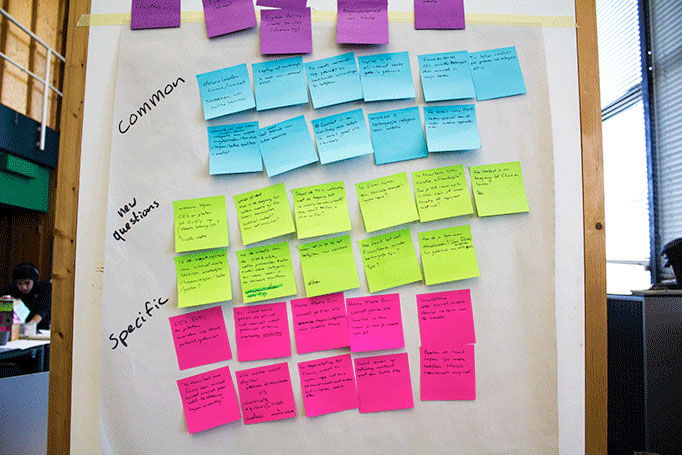PROJECT OVERVIEW
This is a detailed overview of the process about how I developed my research and made decisions based on explorations and results. The first part is really about the positioning of this research within the field of Growing Systems, while the second part explains more about how I performed the research in cooperation with the participants.
Project Growing Systems
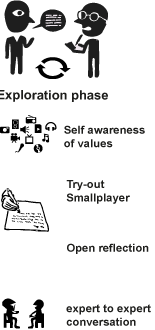
Co-reflection

Using children as target group
Be Your Own System
(Module method)
by Rick de Visser
Coach: Bart Hengeveld

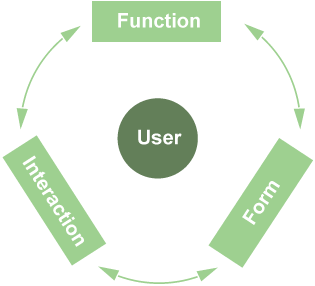
Rich Interaction
This framework shows what you can explore to design from a rich interaction perspective. It is the combination of form, function and interaction that work together and enhance each other’s qualities. I intended to use this framework as a guideline within my research, because it is important for the user to understand and be able interact with a system that is growing. Functionalities will change and therefore the interaction and form. How will this work?

-
Thoughts on project briefing
“As such it has the potential to grow in functionality by adding components.” [1]
In case of smallplayer, components are added digitally. The ability to do this is originally been shaped into a “Trickshop”. This is an online platform in which users can discover “Tricks” that will explain them simply, in a recipe kind of way, how to apply new functionality to their system.
In the context of meaningful interaction I can think of designing the tricks or the Trickshop from a form/interaction kind of way.
The Smallplayer is market to be a system in which you don’t need another remote control, since you can use your smartphone as a remote control. Yet, this does not enhance the interaction between the remote control itself, but does go along with some other convenient advantages, such as not having another device in the collection of remote controls.
“As the physical components of the systems move away from sight, and with the components also the control surfaces, it is no longer possible to directly control the device itself, what is more, it is no longer even possible to perceive what the system is capable of (and what it cannot do).” [1]
Is it then still natural when the system or the devices are hidden? Is it a choice of the designer or the user? Do we not limit the possibilities if we hide physical attributes for interaction?
Possible research questions
Can you “re-shape” existing devices so that they interact with the user and the other devices in a more rich-interactive way?
or
Can you make a smart-phone into a rich interactive device, which can communicate with the TV in a smart manner?

Thoughts on project briefing
How can I transform design for different states
(of growth of a system) into research?
Research question
Can a smartphone be used as a loci for rich interaction?
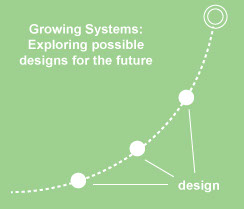
-
First user-test setup
Idea:
A simple downscale “wizard of os” setting in which a “normal” TV corner is simulated. The participants get simple assignments in which they have to try out one specific functionally of the Smallplayer. How they can try out is left open, but we give them a smartphone to use in their interaction. They have to play this out and say what they are doing or thinking out loud.
The functionality must inspire them for types of interaction. We can give triggers for interaction based on function or form.
Questions:
• Do we want a lab-setting or real life setting?
• How to give form triggers of interaction when using a smart phone?
Approach: Base solutions on existing theories
-
Thoughts on implementing co-reflection
Co-Reflection is getting acquainted with the current societal context. Ways to do this are with questionnaire, exploration of the current situation and pictures of home media situations.
Partial the new reality that should “grow” out of the current societal context is already determined in this research, namely the direction towards using a smartphone. How to deal with this without disrupting the methodology of co-reflection?
How does the ideation through a discovery process workout?

“The designer (you) should have a vision on the design case as well to be able to get the confrontation with the vision of the users.”
Meeting with Oscar Tomico

Design iteration
After describing the mission of Smallplayer I thought of an idea for how users could interact with the media services that they want to use. This prototype could function as a design iteration/vision within the co-reflection approach.
Determine vision of Smallplayer and the interaction
Vision is a home media environment, which is open and flexible to include all available services in media.
Mission is to create a platform in which existing and future media services come together.

“Brainstorm about what you actually want to find out”
Joep Frens
Feedback Mid-term
You need parameters to be able to compare and check how the research had work out. Therefore I eventually choose to compare the functionality of Smallplayer with the features that the participants of this project wished they had within their home media environment.

What possibilities are wanted in a home media environment? And how can people use them?
Based on the feedback I received during the mid-term and a coach meeting with Bart. I decided that I wanted to find out two things. First of all I wanted to know what are the need that people have within their media environment. Second of all I wanted to find out how Smallplayer contribute to this need. Because the research needed to focus on home media environments in general and not only on Smallplayer, the research question became:
“What possibilities are wanted in a home media environment? And how can people use them?”
Questionnaire topics
People should be able to gain awareness on specific topics and therefore be able to personally answer the questions:
• What do they consider to be their home media environment
• What trends and developments do they see happening now and in the future
• Where do they picture themselves in this development of media use?
• What media functionalities do they often use in their homes?
• What media functionalities do they still miss?
• What their media rituals are and how they experience them.
These questions should set the stage for the ideation process
Pilot questionnaire
The questionnaire was important for two main reasons: To gather a lot of data from the participants’ perspective on their media use and to make them aware of this perspective. Therefore it was important to shape the questions and structure so, that the participant can reflect on their behavior and values and are tempted to write down a lot of data. I tested this a couple of times with some people who would not be participating further in the research and altered some of the questions before I had sent the questionnaire to the actual participants.
“User behavior is not enough. Important is to know the motivations and emotions that direct the user. And then there is the context. ”
Mathias Funk
Presentation from Matthias Funk
User behavior is not enough. Important is to know the motivations and emotions that direct the user. And then there is the context.
Therefore there is an interview after the questionnaire to detect these motivations and emotions. How to focus on this during the interview?
The context is discovered during the interview at the users home and with the photo assignment.
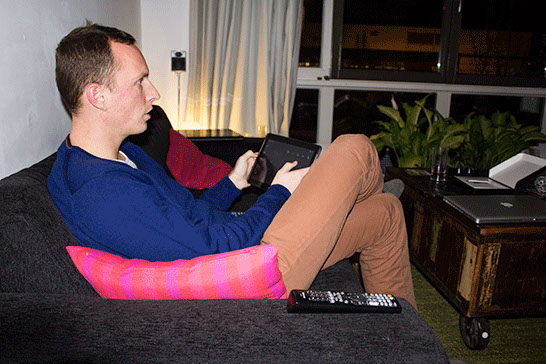
-
Interview setup
The interview is based upon bipolar laddering [5] and the insights of the questionnaire and therefore it consists out of a couple of phases in which we conversed in the following sequence:
1. We first discussed the different media rituals from the questionnaire. During this part I have the specific answers of the participants in front of me. First we look at the answers that the participants had given in the questionnaire and from there on we continue to explore how this scenario unfold. I ask detailed questions on how they act and what they find important in this “media ritual”. If applicable we would go to the place where the ritual takes place and some participants acted out how they perform the ritual.
2. I asked the participant some specific questions that I created during the analyses of the questionnaire answers. Here I had the chance to learn the perspective of the participant towards certain topics that were addressed in the answers of other participants. I ordered the questions on the three types of media I discovered from the questionnaire. These categories are “physical media”, “digitally owned media”, and “online streaming media”. Strickly speaking some types of media would fit in more than one category. Therefore I explained the three categories as:
Physical media: All the media that is stored by a manufacturer on a physical form, such as a DVD, a record plate or a CD.
Digitally owned media: All the media that you have stored on a harddisk or a computer, but is offline available.
Online streaming media: All the media that you stream directly from the internet when playing.
3. I asked the users to comment on a few statements that were coming directly out of the questionnaire answers. I selected these statements, because they represented an interesting or extreme perspective on media use.
4. During the conversation we were often already able to point out elements of media use that the participant find important or has already an idea how he/she would like this to work if that was possible. In this phase we did a recap of these elements and made it a concrete list of things the users find important. Then we discussed how they would like to have a home media environment if there were no technological limitations. Since the participants were at this point very much aware of their values on the use of media, a description of a futuristic scenario of their home media environment was no problem to envision.
During the time I was with the participants I focused on the motivation and emotions of how and why users use their media and I observed the context in which the experience takes place.
-
“You cannot compare a conceptualized idea with a full product such as Smallplayer. Or you should give a much detailed reference what they need to compare.”
Oscar TomicoMeeting with Oscar
In this meeting we reflected back on the process so far, to be able to propose the next step in the project that would make sense. We concluded that in this project there are different phases with each their own goal. Each phase generated a specific type of information.
“You cannot compare a conceptualized idea with a full product such as Smallplayer. Or you should give a much detailed reference what they need to compare.”
At this point I altered from the original co-reflection method, because I wanted to evaluate Smallplayer. Since this is a fully working product, it doesn’t make sense to confront this product with the vision of the participants about a conceptual idea of their home media environment.
I decided to further in this process until I had a clear result in which elements of the future scenario of the participants Smallplayer covers from the perspective of the users, because this was the depth I could manage within the timespan of this project. Getting concrete insight in how people interact with Smallplayer and how this can be improved can be done in a subsequent research study.
Users had the possibility to try-out Smallplayer in their home environment after the interview took place. After discussing their future scenario, I installed Smallplayer and pointed out which features that they found important were now available through Smallplayer.

-
CLICK HERE TO OPEN THE LIST OF WISHES
-
COLLECTION OF MEDIA 1-5
1. I want to maintain a nice looking and insightful media collection (online and offline), in which I (or possible other users) simply have to add media.
2. I want to be able to view the media collection of friends (and play from this collection in my own system).
3. I want to collect media that I want to watch in the future through services or friends from who I get recommendations. An overview of this collection should be visible in my media system.
4. I want to play the media that I select in my “still to watch” collection directly from my media system.
5. I want to be able to see which films or tv-shows I have already watched.
-
AVAILABILITY OF MEDIA 6-7
6. I want the most recent films, tv-shows and music immediately available on my media system.
7. I want the possibility to search for available online media on my media system and play this selection immediately.
-
INTEGRATION HOME MEDIA ENVIRONMENT 8-15
8. I want that all my media devices can be connected wireless if needed.
9. I want access to my complete media collection via all the media devices I use at home (also the TV).
10. I want access to the online media service that I often use (like spotify, netflex, youtube, nu.nl) via all the media devices I use at home.
11. I want to connect all the online media services that I use. For example, so that I can start a movie directly from IMDB, that I can watch a trailer from Youtube from my media library or that my music collection automatically is filled with music from my Shazam tags.
12. I want that the media that I select online or already played before, is also available without internet connection.
13. I want that my media system remembers where I stopped watching/listening and continue at this point (or a few seconds back for recapitulation) when a want to continue watching/listingen in time.
14. I always want subtitles available, with a choice whether I turn it on and in what language.
15. I want to use my television only as an output device for my media and let the interaction for controlling my media take place between me and my mobile devices.
-
SUGGESTIONS OF THE SYSTEM 16-19
16. I want that my media system automatically shows me the newest episodes of the tv-shows I watch directly when they are available.
17. I want that my media system can show me a small selection of movies/tv-shows/songs as a suggestion to watch/listen to and which will refresh after a short period of time to show new content.
18. I want that my system recognizes in what mood I am and suggest relevant media to watch or listen to.
19. I want access to a music streaming function that is filled with music that I like.
-
QUALITY OF MEDIA 20
20. I want that all the available media, online and offline, meet the highest quality standards of my media devices.
-
LIVE MEDIA 21-22
21. I want to see which song/tv-show I am listening/watching or have listened/watched earlier during live feed (like radio).
22. I want the option of having a surprising selection of tv-shows based on my interests, with the same ease of use as with watching traditional television. (Interests can be news-shows, reality tv, etc.)
-
OTHER 23-26
23. I want no commercials on which I have to wait before I can continue to use my media.
24. I want to see the time of when the movie or tv-show I watch is finished.
25. I want to be able to integrate all my physical media with the possibilities of digital media and online media services. For example being able to listing to songs on my smartphone that originally came from my music record collection.
26. I want to recommend films or music to my friends through my media system.
-
-
Setup Evaluation Form
I have setup the evaluation form so that every wish could be evaluated on three aspects on the scale of 1 to 7. I used a scale to collect results that I could compare with each other.
The first aspect that should become clear was how much the users would want the wish to be true. By knowing this I could determine what is important to develop when designing (part of) a home media environment. Realistic knowledge of what users want is also important to make a growing system happening.
The second aspect was to find out how the users experienced Smallplayer on the subject proposed by the wish in terms of a good or bad experience. Although the participants could explain their judgment in the form as well, this phase of the research is not yet focused on finding out how the interaction is experienced in detail.
The third aspect was to find out how the users experienced their home media environment before they had Smallplayer installed on the subject proposed by the wish. The users use the same scale for their answer as the question about the experience of Smallplayer so they can also compare the two situations with each other.
The scale from 1 to 7 is based upon the following:
1 - Very negative
2 – Negative
3 – Little negative
4 – Neutral
5 – Little positive
6 – Positive
7 – Very positive
However, I only specified the two extremes and the neutral option, because I wanted the participants to focus on the subjective relativities on the scale and not on the precise meaning of the options.
-
Reflection home media paper with OSCAR device
I found a paper [7] about a setup in which they tested a home media environment that connects all the devices en services at home, called OSCAR. Although I agree with their overall vision, the OSCAR device is a prototype that only works within their controlled Lab-setting. Yet they state that people use their devices often with multiple purposes that change over time during their product life. While working in a real life setting, we know that the challenge of integrating a network of media devices lays in all the different communication protocols that these wide variety of home media devices use. Especially because you can easily assume no one will completely switch their current “system” with an entire new system, even when this system is able to connect these new devices like the OSCAR prototype.

